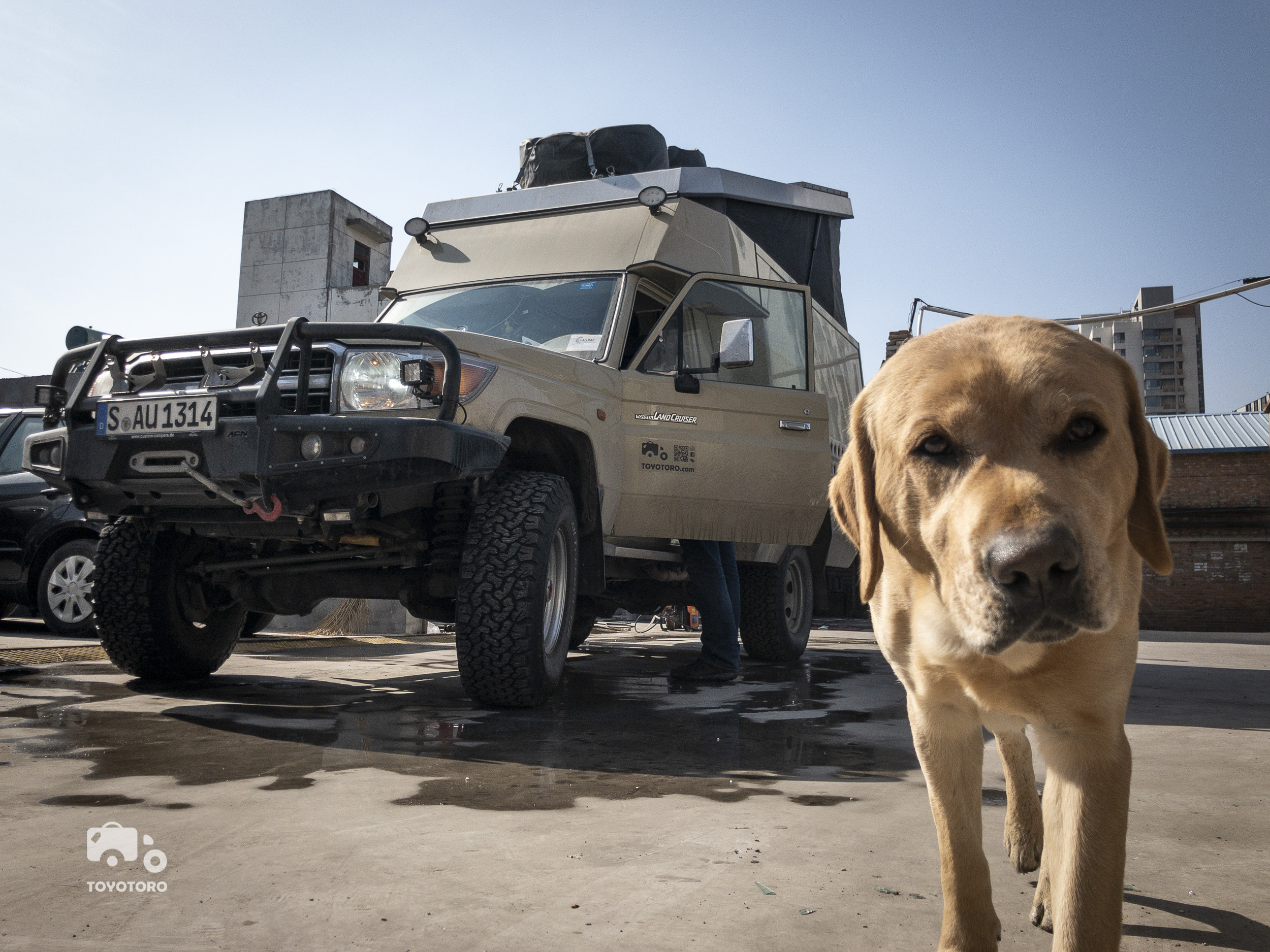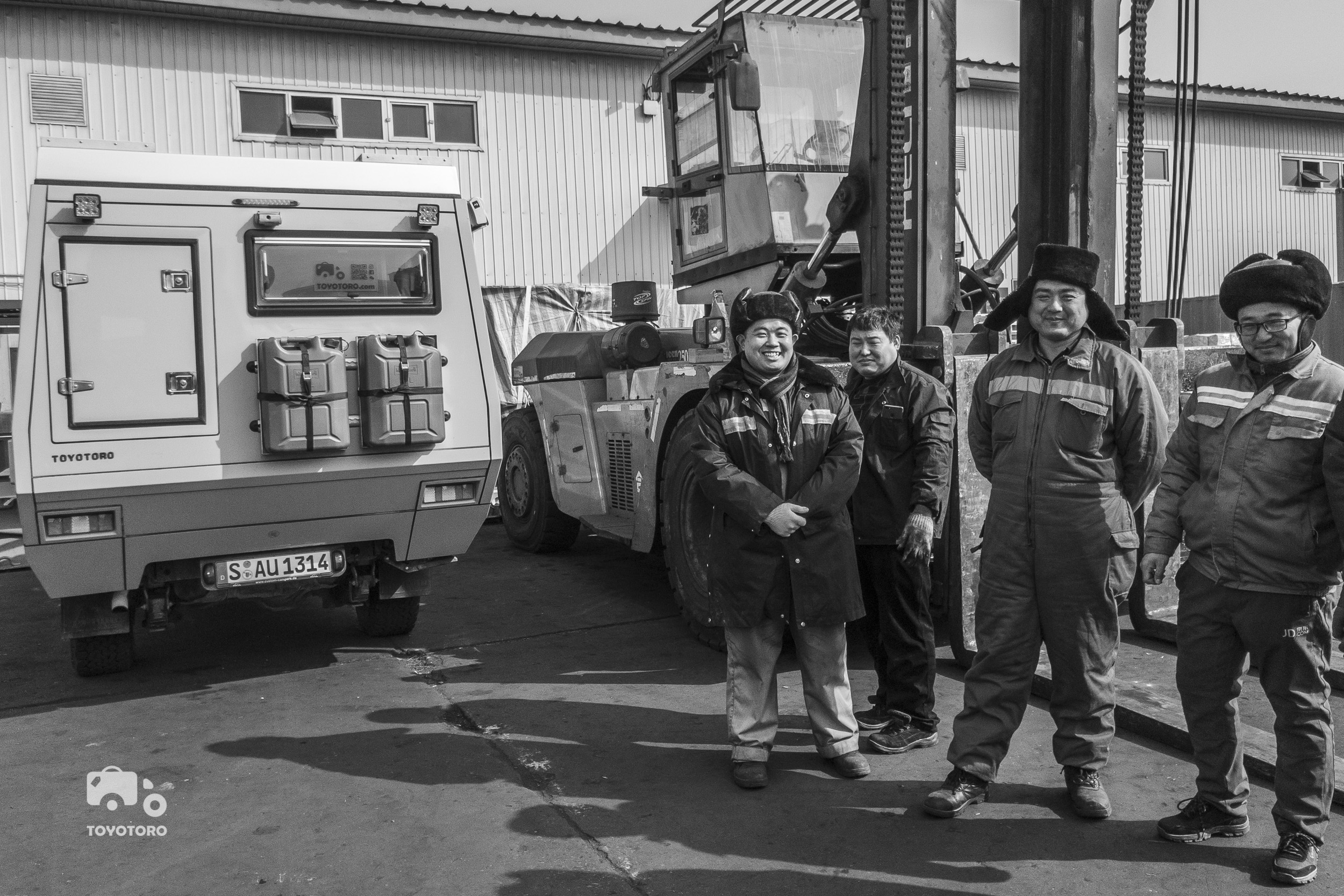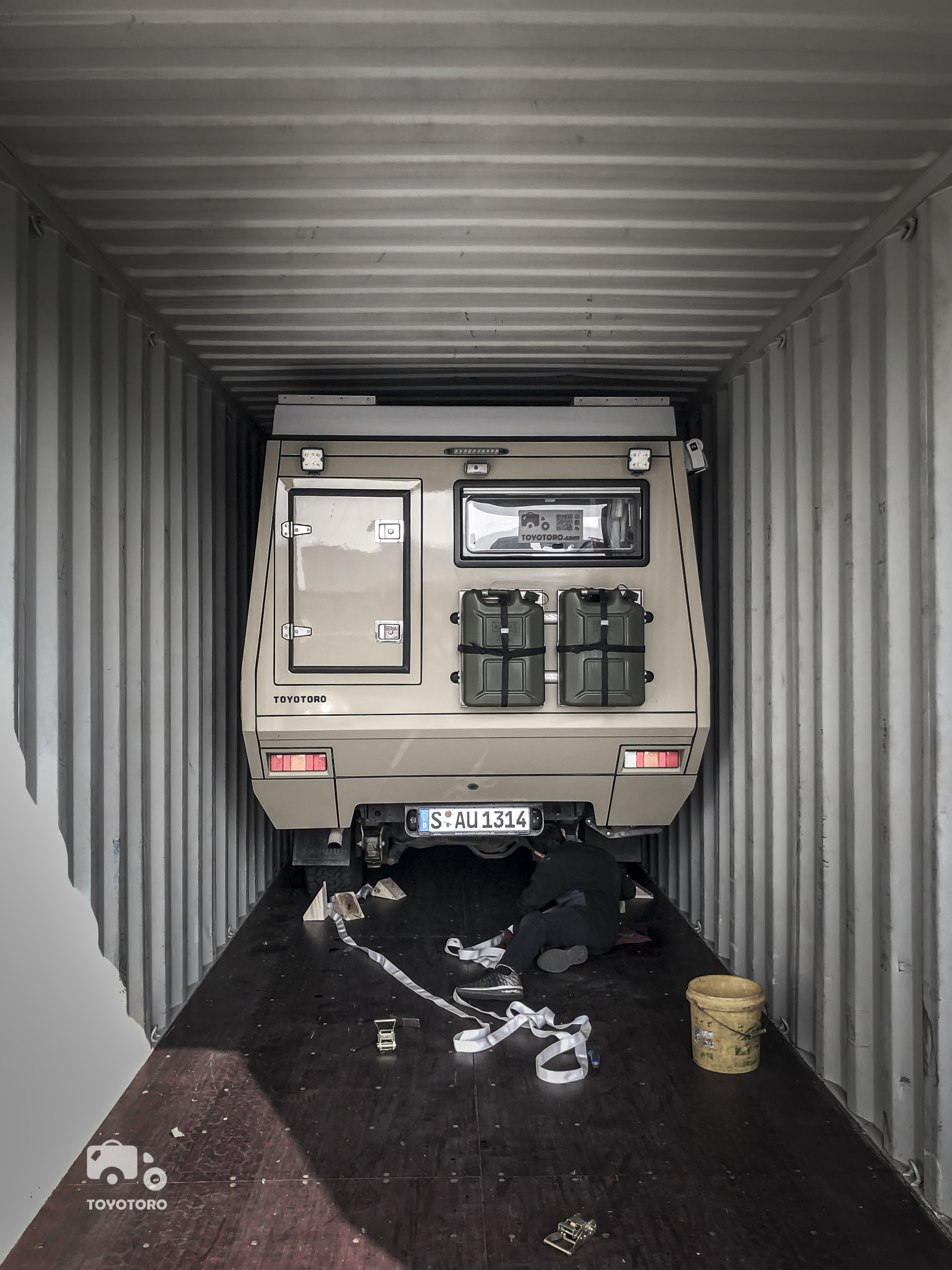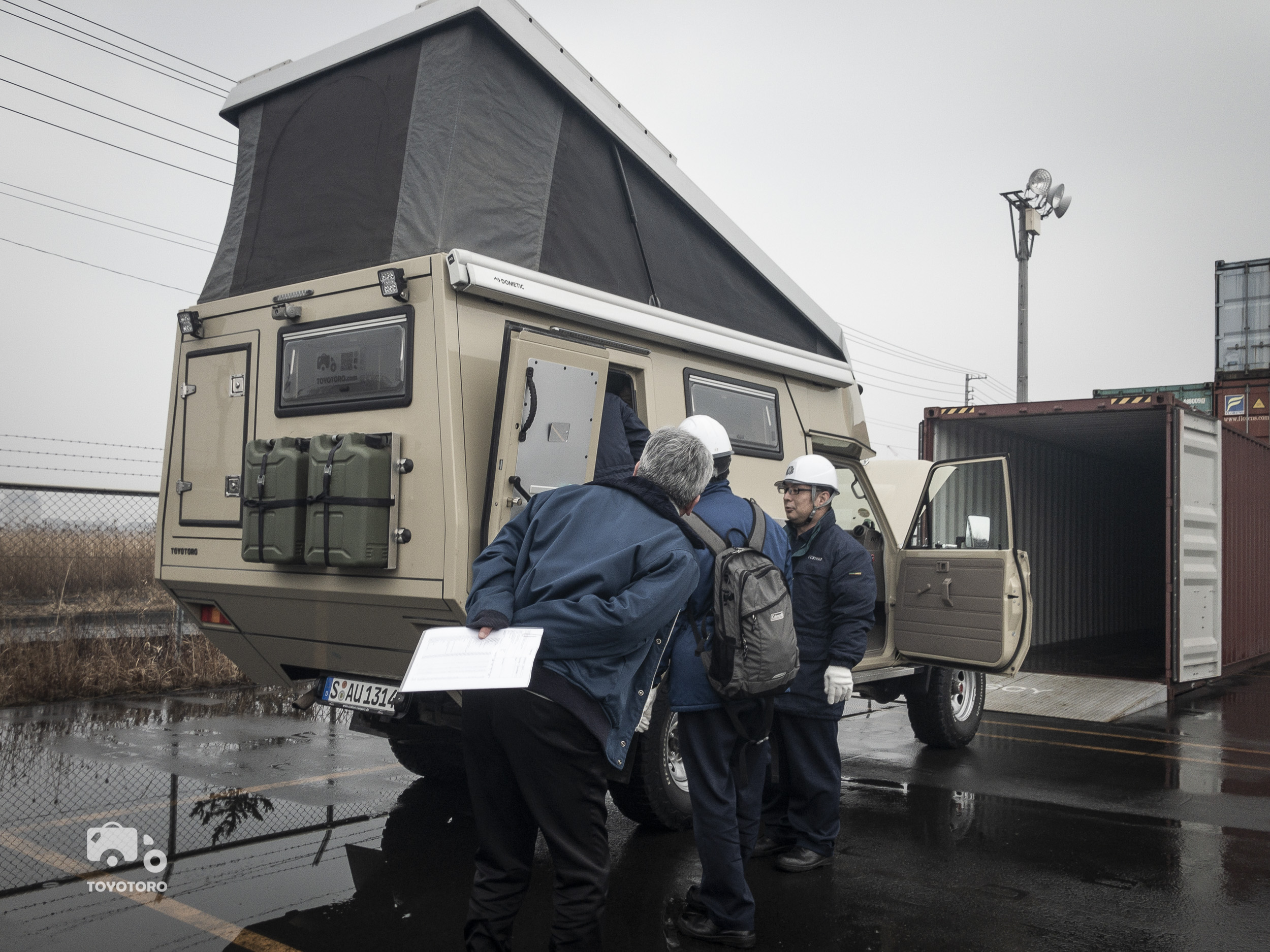
First and foremost, we successfully drove in Japan for 4 months with our German-licenced car.
According to Japan Automobile Federation (JAF) this should be impossible:
If a temporarily imported vehicle is registered in a country that is not a party to the aforementioned treaty (as it were, Germany, Switzerland, Monaco Slovenia), it must be inspected and registered in Japan on arrival, even if imported under cover of CPD.
As far as we know this ‘inspection’ and ‘registration’ cost a lot of money and time. In addition, you needed the help of a Japanese resident. Therefore, it was not an option for us to do it the ‘proper way’.

The key to entering Japan with a German-licensed vehicle, avoiding this proper process, is knowing with assurance, that each organisation, be it JAF, customs agents or shipping agents, are separated. Each party focuses on their own tasks and do not operate outside of it. Additionally, most policemen and -women are seemingly not aware of the treaty-issue.
Our sequence of procedure from China to Japan
- Choose port and Chinese shipping company —> Tomakomai, Japan
- Find Japanese customs agent —> done by Chinese shipping company
- E-mailing JAF our CdP for authentication and driver’s license for translation
- Basic cleaning of car in China
- Shipping from Tianjin
- Arriving in Japan by plane: important – mention “unaccompanied luggage” to customs, show Carnet, include “personal items list”
- Waiting for arrival – will most likely be delayed
- Get Jibaiseki from local insurance agent
- Container opening by customs agent with you present
- Drive car out of container ourselves. Lock car again till customs release
- Customs agent takes us to customs office #1 for car/Carnet declaration, then customs office #2 for personal items declaration
- Additional customs inspection for personal items – additional cost apply (400USD)
- Carnet and personal items list stamped
- Done! Enjoy Japan
- Police encounters and lessons learnt
Now the details…

Which port in Japan?
We read a lot on the internet regarding German/Slovenian/Monacan vehicles entering Japan with most saying it is impossible. But every now and then we read stories about those who just went for it and made it. This gave us hope to gamble and it paid off.
After some consideration we chose Tomakomai (苫小牧) in Hokkaido for the following reasons:
- Small port, hoping this would mean less bureaucracy and process.
- Small town full of locals who are just not aware of the ‘special cases’, therefore they treat the whole procedure with friendly curiosity as opposed to suspicion.
- We entered early March and we intended to hit the ski-slopes.
Downside of Tomakomai:
- Small port means less cargo ships going to Tomakomai. Our car took two weeks to arrive when we thought it only took one. It turns out it wanted to make a stop in Busan, Korean, just for kicks, before it decided to grace us with its presence in Tomakomai.
- It will probably cost a few hundred dollars more in handling fees than bigger ports, such as Tokyo/Yokohama etc.
Roll-on-roll-off (RoRo) or Container?
We came in highcube container from Tianjin. No choice for RoRo coming from China.

Which shipping company?
On the Chinese side we used Tianjin Waidai Jiaming Huoyun(天津外代嘉明货运)and on the Japanese side we used Sunrise Logistics Company Limited (東興物流株式会社) – this was a choice made by the Chinese shipping company not by us as we entrusted them in finding their Japanese counterpart.
Getting our car out of China was not a problem as there are numerous freight companies that leave China and from the port of your choosing. The Japanese side is more troublesome. We also privately contacted a few and all, but they all came back saying they could not receive our vehicle for various trivial and frustrating reasons.
Sunrise Logistics Company Limited does not have an agent in Tomakomai so they had to use another local company called Narasaki-Stax (ナラサキスタックス株式会社). Both very competent companies who managed our car professionally (though Sunrise Logistics needed a bit chasing up at times). The agent from Narasaki-Stax was essential for us because he is the one doing the paperwork and our gateway to the local customs guys, who can authorise the clearance of our car from the shipping yard. If we chose larger ports to come into Japan e.g. Tokyo, Yokohama or Osaka etc., then we probably would not have needed Narasaki-Stax and cut on the extra costs. A Dutch couple we met in Japan went with RoRo into Yokohama and they did the customs clearance by themselves.
Important to note when giving information to the Japanese shipping company
One lesson to take away from this whole process is to provide the Japanese shipping company with:
- A list of personal items in your car (including quantity, value and weight of each/collective items. Our ‘packing list’, that we showed to customs, totals to about 5000 EUR and that was the figure they wrote down in the official customs paper).
- Print out the ‘packing list’ and show it to the customs guy when you land in Japan, whether it be by plane or other form of transportation. He will be a bit confused and in awe of the nature of your trip and might not know what to do but make sure he marks the list to indicate he acknowledges that there is a vehicle coming into Japan AND in the vehicle, there are personal items too. So you are declaring two items, the car and its contents.
I am emphasising this because due to some mis-communication between the Chinese and Japanese side we did not provide such a list to the Japanese side nor to the customs guy when we landed in Osaka (on our customs slip it only says “1 car” which proved to be a major problem because apparently this doesn’t include all the stuff in the car). This resulted in an extra week of waiting around, organising an inspection, while hunting down different customs guys (one that took care of the car and one of its content, and no, they are not the same people) to explain to them there’s nothing dangerous, just old rags and used goods in our car.
NB: It is advisable to avoid items like “petrol stove”, “chemical toilet liquid”, “oil”, “dry food” or “cooking ingredients” in the list as it will backfire when you ship out and the RoRo company will force you to remove them.
In the end we managed to avoid the more extensive inspection (but still have to pay 400 USD) and the ‘declaration of personal effects’ cost (200 USD) and transportation cost (60 USD) from terminal to inspection yard. The inspection itself was quite a funny affair and frankly a bit of a joke for the money you pay for it. It lasted no more than 30 minutes and it involved 4 inspectors, a supervisor, our agent and 3 of his workers. It looked like a group of Minions with their little helmets playing with a new big toy they just found.
We don’t know if by providing the list would mean we’d avoid the inspection. But speaking to the local agent and two customs guys, it seems like it would definitely have sped up the process of getting the car on the road. What other process that would’ve popped up instead of the inspection, I hope, we don’t have the privilege to find out.
Condition of car before shipping to Japan
The Chinese shipping company informed us as long as the car is not too dirty then it’s ok to ship. They also said we should dispose our gas cylinder. We conveniently did not follow up on that advise and all was well.
In the end we just washed the outside of the car and gave the inside a tidying-up (clothes and things stored away etc.). When it arrived in Japan there was no mention of the car’s exterior nor interior condition.
While in Japan, waiting for the car to arrive…
Buying Jibaiseki (自賠責)
Jibaiseki = mandatory and very basic car insurance. Not recommended to just use Jibaiseki coverage, we are covered by our worldwide car insurance, please check if you need to obtain additional coverage for Japan.
As we waited for our car to arrive at the port we went Jibaiseki hunting. Technically this job should be the task of the receiving end of the container, so our Japanese counterpart but since they never received a vehicle before in Tomakomai we had to do the leg work. We read online that it was easy. You just walk into any dealer and they’ll issue it to you with your VIN number. This definitely was not the case with us.
We went to a few car dealers in Sapporo, mainly around JAF (where they issued our Carnet authentication) and an insurance company. That strip of road outside JAF is full of car dealers and service centres. They all wanted MOT or Shaken (車検) and it didn’t seem to matter which country our car is from. But mostly we got the impression they didn’t know what to do when dealing with an anomaly such as ourselves.
We eventually went to a company called Sompo Japan Nipponkoa (損保ジャパン日本興亜) that specifically deals with damage insurance a.k.a. Jibaiseki. After some explaining (in Japanese) a lady sold it to us and that was because she found in her Jibaiseki handbook that they can sell it to foreigners without a Japanese licence and no proof of shaken/MOT needed. Most importantly the handbook didn’t mention it was not possible for German/Slovanian/Monaco licenced vehicles.
Deal maker for getting Jibaiseki:
- To have your Vehicle Registration Certificate translated into Japanese (we translated this ourselves into Japanese and it was important for her to know important info. e.g. type of vehicle, size, VIN no., address (can write a hotel if necessary). She didn’t understand any of the English let alone the German, so it’s important to help her find the info she is looking for.
- Speak Japanese
- Cash in hand (no card payment)
- Perseverance and with a bit of luck!
JAF
Dealing with JAF was pretty straightforward even though we confused them at the beginning. We didn’t know which port to best come into Japan so at the time we told JAF (in the e-mail we attached a copy of a) Carnet copy and b) drivers’ licence copy) we’d be coming into Fukuoka, so they gave us the contact info of that branch. Two weeks before our car arrived we informed them the car is actually going to be in Hokkaido. They were surprised but was efficient in sending our info to JAF Sapporo branch.
Before we went to the JAF Sapporo branch we made sure to call the lady, with whom we’d been in contact with, to book a date and time in which we could pick up our Carnet authentication document. When we arrived, we picked it up free of charge. We asked her to translate Henning’s German driver’s licence into Japanese, which she did for a fee of 3000 yen and it took her only a few minutes. As for my UK driver’s licence she didn’t know what to do so we left it.
NB. According to GOV.UK the International Driving Permit (IDP) is sufficient for UK-citizens to drive in Japan since it’s based on Geneva Convention on Road Traffic of September 19, 1949 (while the German IDP is based on the 1968’s convention which Japan has apparently not ratified). Therefore, no translation necessary for the UK licence.

Encounters with the Japanese police
During our four-month trip we covered all four main islands: Hokkaido, Honshu, Kyushu and Shikoku. We’ve had four encounters with the police. Two in Honshu and two in Kyushu. The first was the longest. We parked somewhere where we shouldn’t have, and our mistake cost us two hours of back-and-forth explanation with four policemen who didn’t really know what to do but at the same time were reluctant to let us go (they even called JAF but luckily didn’t get through to the right person responsible). In the end we let them take photos of our car and all our documents, so they can ‘study’ this case because it’s their first time meeting a foreign number plate. The other three times were short encounters that mainly involved showing them we are not bad people and we have the relevant documents e.g. showing passport and Jibaiseki.
The general feeling we got from the encounters are:
- Japanese police do not really know how to handle a foreign plate whether you are German or Dutch or whatever. But some will feel it is their duty to approach an ‘alien’ vehicle and tick the boxes to the questions they are supposed to ask.
- If you are obeying Japanese traffic regulations and not breaking any rules, then you will not be bothered. Two out of four of those encounters we had was because we were in the wrong with some kind road regulation. No matter how trivial you might think. Like the Germans, the Japanese are pedantic.
- The most important documents to put forward during a police check are Carnet (including the Japanese authentication by JAF) indicating that you are allowed to drive in Japan as tourist with foreign vehicle; and Jibaiseki; and Japanese translation of driver’s license. Most will be satisfied with these three to let you continue cruising.
- We often stayed over at Michi-no-eki (a fully equipped service station for travellers but a sanctuary for overlanders) which meant we were more exposed. If we did more off-road camping, then we’d definitely have had even less encounters with the police.
Leaving Japan
We left Japan for Malaysia on the RoRo service (half the price of container). After inquiring with different shipping companies, we settled for AutoHub Japan based in Osaka, who gave us the best quote in Japanese Yen (including tax):
NB: make sure to include actual vehicle’s dimension in quote request since RoRo cost are volume-based
Ocean Freight: 97,200 JPY
Light Plan: 32,400 JPY
Radiation Examination: 1,080 JPY
Total = 130,680 JPY (around 1,064 EUR)
The checking procedure of AutoHub as follows:
- Autohub spends one day of semi-thoroughly checking the car. They took all our food out from various compartments and put them in a separate bag, which itself is a lot of work but then they didn’t cover all areas of our car e.g. didn’t spot the 2kg gas bottle nor engine oil etc.
- Make sure your personal item list doesn’t include suspicious terms (as mentioned before) because Autohub would ask you to remove them.
- We needed to stay around (roughly 3-4 days for us) until customs check takes place
- Autohub prepared the customs appointment well so it took only 5mins, no check of personal items took place. Customs only asked to see our drone which AutoHub staff produced in a flash ad since ours is a small one (430g) it was not a problem.
- RoRo shipping company itself didn’t check back of the car/personal items again.

We respect GDPR/DSGVO and your data, IP addresses will be deleted.

This Post Has 4 Comments
Pingback: Wa 和: Harmony, order, and self-development • Toyotoro
Pingback: URL
Ein tolles Fahrzeug und Reisebericht, da werde ich wohl noch Stunden zum stöbern haben!
Welche Autoversicherung habt ihr abgeschlossen? IIhr hattet ja eine Weltweite Abdeckung – ich nehme an mit Kasko?
Gruss, Heinz
Moin Heinz, Danke fuers Kompliment, freut uns!
Wir hatten in der Tat die weltweite Camper-Versicherung von Jahn & Partner… jedoch denke ich, dass wir das beim naechsten Trip anders machen werden. Einige Laender auf dem Weg haben eh ihre eigenen, lokalen Versicherungen erfordert. Lediglich im Gebiet der Gruenen Karte hat es Sinn gemacht fuer uns.
Wenn du ein neues, hochwertiges Fzg. hast, dann macht eine weltweite Vollkasko sicherlich Sinn fuer dich. Ich denke jedoch, wir werden’s naechstes Mal sein lassen und riskieren 😉
Viele Gruesse und gute Reise
Henning